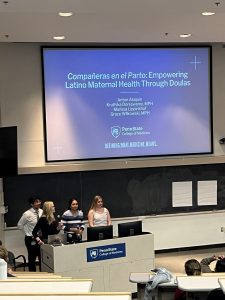College of Medicine students launch first-ever global health case competition at College of Medicine – Penn State Health News

Report on the Inaugural Global Health Case Competition at Penn State College of Medicine
Introduction
On October 17, 2025, the Penn State College of Medicine hosted its inaugural global health case competition. Organized by the student-led Global Health Interest Group with faculty mentorship, the event was designed to provide students with experiential learning in public health problem-solving, with a direct focus on advancing the United Nations Sustainable Development Goals (SDGs).
Competition Overview and Strategic Focus
The competition centered on the theme, “Prenatal care for Latin American migrants in Pennsylvania.” This topic was selected to address critical health disparities and align with global health priorities. The event’s development was spearheaded by the Global Health Interest Group executive board, which includes Eva Eleftheriadis, Anna Verevkina, Johanna Linna, Sundip Singh, and Swetha Ampabathina, under the guidance of Dr. Julie Lentes. The competition drew 29 participants from the MD, PhD, DrPH, and MPH programs, who formed seven interdisciplinary teams, embodying the collaborative spirit of SDG 17 (Partnerships for the Goals).
Alignment with Sustainable Development Goals (SDGs)
The competition’s framework and theme were intrinsically linked to several key SDGs:
- SDG 3: Good Health and Well-being: The core focus on prenatal care directly addresses Target 3.1, aiming to reduce the global maternal mortality ratio. Proposed solutions sought to ensure universal access to sexual and reproductive health-care services for a vulnerable population.
- SDG 10: Reduced Inequalities: By concentrating on the health needs of migrants, the competition challenged participants to develop strategies to reduce inequalities in healthcare access and outcomes, in line with Target 10.2, which aims to empower and promote the social, economic, and political inclusion of all.
- SDG 4: Quality Education: The event served as an innovative educational platform, providing future healthcare professionals with the critical thinking and problem-solving skills necessary to address complex global health issues, contributing to Target 4.7.
- SDG 5: Gender Equality: Improving access to maternal and prenatal care is fundamental to ensuring women’s health and well-being, a cornerstone of gender equality.
Proposed Solutions and Adjudication
Participating teams presented a range of public health strategies aimed at improving health outcomes and reducing inequalities. These included mobile prenatal clinics, pop-up telehealth stations, culturally tailored support groups, and multilingual hotlines. A panel of faculty judges evaluated the proposals based on their feasibility, innovation, and potential impact on SDG-related targets.
Competition Outcomes
The judging panel, comprising Dr. Julie Lentes, Dr. Kristin Sznajder, and Dr. Nirmal Ahuja, recognized the following teams:
- First Place: Grace Wilkowski, Marissa Lippinkhof, Anton Aluquin, and Kruthika Doreswamy. Their winning proposal, “Compañeras en el Parto,” is a doula education and community pipeline program designed to provide culturally competent maternal support, directly advancing SDG 3 and SDG 10.
- Second Place: Emily Wertz, Brady Dolan, Anna Verevkina, Eva Eleftheriadis, Kaitlyn Kutz, and Ilana Korogodsky.
- Third Place: Angel Chou, Victor Lin, and Shakila Shah.
Conclusion and Future Directions
The inaugural global health case competition successfully integrated principles of the Sustainable Development Goals into medical and public health education. It fostered a humanistic and holistic approach to healthcare, encouraging students to analyze and address systemic health inequities. The Global Health Interest Group intends to establish this competition as an annual tradition, continuing to build capacity among future leaders to create a healthier, more equitable world for all populations and advance the 2030 Agenda for Sustainable Development.
SDGs Addressed in the Article
The following Sustainable Development Goals are connected to the issues highlighted in the article:
- SDG 3: Good Health and Well-being: The article’s central theme is a competition focused on improving “Prenatal care for Latin American migrants in Pennsylvania.” This directly addresses the goal of ensuring healthy lives and promoting well-being, particularly for mothers and children within a vulnerable population. The proposed solutions, such as “mobile prenatal clinics” and “doula education,” are practical strategies to enhance health outcomes.
- SDG 10: Reduced Inequalities: By focusing on a specific migrant group, the article highlights the need to address health disparities. The competition aims to develop strategies that make “health care better for all populations,” thereby reducing inequalities in access to essential services for marginalized communities like Latin American migrants.
- SDG 4: Quality Education: The article describes an educational event—the “inaugural global health case competition”—that provides medical students with “experiential learning in global health.” This initiative enhances the quality of medical education by equipping future physicians with skills in “real-world public health problem-solving” and a “humanistic, holistic lens.”
- SDG 5: Gender Equality: The focus on prenatal care is intrinsically linked to women’s health. Ensuring accessible and culturally appropriate prenatal care, as explored in the competition, is a crucial step toward empowering women and ensuring their well-being, which is a cornerstone of gender equality. The winning “doula education and community pipeline program” is a direct service supporting women’s health.
Specific SDG Targets Identified
Based on the article’s content, the following specific SDG targets can be identified:
- Target 3.1: By 2030, reduce the global maternal mortality ratio. The competition’s focus on improving prenatal care is a primary strategy for preventing complications during pregnancy and childbirth, which directly contributes to reducing maternal mortality.
- Target 3.8: Achieve universal health coverage, including access to quality essential health-care services for all. The challenge of providing prenatal care to migrants and the proposed solutions like “mobile prenatal clinics” and “pop-up telehealth stations” are directly aimed at extending essential health services to an underserved population, aligning with the goal of universal health coverage.
- Target 10.2: By 2030, empower and promote the social… inclusion of all, irrespective of… origin… or other status. The development of “culturally tailored support groups and multilingual hotlines” aims to overcome social and linguistic barriers, promoting the inclusion of Latin American migrants in the healthcare system.
- Target 4.7: By 2030, ensure that all learners acquire the knowledge and skills needed to promote sustainable development… and global citizenship. The case competition provides medical students with practical knowledge and skills in global health, fostering a perspective that helps them “critically analyze our own system” and work towards global health equity.
Indicators for Measuring Progress
The article mentions or implies the following indicators to measure progress toward the identified targets:
- Indicator for Target 3.8 (Access to Services): The article implies that the number and reach of the proposed interventions could serve as indicators. This includes the number of “mobile prenatal clinics” established, the number of “pop-up telehealth stations” deployed, or the number of women served by the “doula education and community pipeline program.”
- Indicator for Target 10.2 (Inclusion): The utilization of culturally specific services can be an indicator. For example, the number of calls received by “multilingual hotlines” or the number of participants in “culturally tailored support groups” would measure the successful inclusion of the target population.
- Indicator for Target 4.7 (Educational Opportunities): The article provides direct indicators for educational progress. This includes the number of student participants in the competition (“29 participants across the MD, PhD, DrPH, and MPH programs”) and the establishment of the competition as an “annual tradition,” which signifies a sustained commitment to global health education.
Table of Findings: SDGs, Targets, and Indicators
| SDGs | Targets | Indicators (Implied from the article) |
|---|---|---|
| SDG 3: Good Health and Well-being | 3.1: Reduce maternal mortality. 3.8: Achieve universal health coverage and access to quality essential health-care services. |
|
| SDG 10: Reduced Inequalities | 10.2: Promote the inclusion of all, irrespective of origin. |
|
| SDG 4: Quality Education | 4.7: Ensure learners acquire knowledge and skills for sustainable development and global citizenship. |
|
| SDG 5: Gender Equality | 5.6: Ensure universal access to sexual and reproductive health. |
|
Source: pennstatehealthnews.org
What is Your Reaction?
 Like
0
Like
0
 Dislike
0
Dislike
0
 Love
0
Love
0
 Funny
0
Funny
0
 Angry
0
Angry
0
 Sad
0
Sad
0
 Wow
0
Wow
0




















































.jpg.webp?itok=0ZsAnae9#)
















/countries/sri-lanka/photo-credit---dmc-sri-lanka.tmb-1200v.jpg?sfvrsn=dc298bcc_1#)









